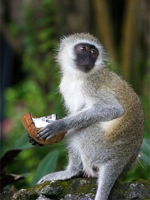Dit bericht is geplaatst op woensdag 18 juni 2008 om 10:50 in categorieën Puzzels. Je kunt de reacties volgen via een RSS 2.0 feed. Je kunt een reactie plaatsen, of een trackback van je eigen site plaatsen.
Wiskundemeisjes
Ionica & Jeanine
De aap en de kokosnoten
In Puzzels, door Ionica
Op zoek naar informatie over Farey sequences plukte ik Introduction to number theory van Daniel E. Flath uit de bibliotheek. In de inleiding las ik
My own conscious interest in Diophantine equations goes back to a long winter's night in a St. Louis basement in 1962 when my father and I tried to solve the notorious problem of the monkey and the coconuts as presented by Martin Gardner.
Ik was gelijk benieuwd naar deze blijkbaar beruchte puzzel. Toevallig heb ik de verzamelde columns van Gardner op mijn laptop staan en een zoekopdracht 'monkey coconuts' leidde me naar The Second Scientific American Book of Mathematical Puzzles and Diversions. Ik ga de eerste twee bladzijden van zijn column hier gewoon kopiëren, want beter opschrijven dan Gardner kan ik het toch niet.
In the October 9, 1926, issue of The Saturday Evening Post appeared a short story by Ben Ames Williams entitled "Coconuts." The story concerned a building contractor who was anxious to prevent a competitor from getting an important contract. A shrewd employee of the contractor, knowing the competitor's passion for recreational mathematics, presented him with a problem so exasperating that while he was preoccupied with solving it he forgot to enter his bid before the deadline. Here is the problem exactly as the clerk in Williams's story phrased it:
"Five men and a monkey were shipwrecked on a desert island, and they spent the first day gathering coconuts for food. Piled them all up together and then went to sleep for the night. But when they were all asleep one man woke up, and he thought there might be a row about dividing the coconuts in the morning, so he decided to take his share. So he divided the coconuts into five piles. He had one coconut left over, and he gave that to the monkey, and he hid his pile and put the rest all back together.
By and by the next man woke up and did the same thing. And he had one left over, and he gave it to the monkey. And all five of the men did the same thing, one after the other; each one taking a fifth of the coconuts in the pile when he woke up, and each one having one left over for the monkey. And in the morning they divided what coconuts were left, and they came out in five equal shares. Of course each one must have known there were coconuts missing ; but each one was guilty as the others, so they didn't say anything. How many coconuts were there in the beginning?"
Williams neglected to include the answer in his story. It is said that the offices of The Saturday Evening Post were showered with some 2,000 letters during the first week after the issue appeared. George Horace Lorimer, then editor-in-chief, sent Williams the following historic wire: FOR THE LOVE OF MIKE, HOW MANY COCONUTS? HELL POPPING AROUND HERE.
Wie de rest van de column wil lezen (met daarin verschillende versies van dit probleem én methodes om de oplossing te vinden) moet vooral het boek van Gardner kopen. Enthousiaste lezers mogen (for the love of Mike) natuurlijk ook in de reacties vertellen hoeveel kokosnoten er lagen toen de mannen gingen slapen.
 Internetbureau Rotterdam
Internetbureau Rotterdam 

